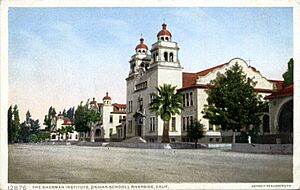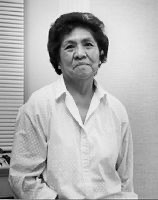Mae Timbimboo Parry facts for kids
Mae Timbimboo Parry (born May 15, 1919 – died March 20, 2007) was an important storyteller and leader for the Northwestern Band of the Shoshone Nation in Utah. She was also an activist who worked to protect the culture and land rights of Native American people. Mae was well-known for sharing the true story of the Bear River Massacre. She also worked closely with the Shoshone people and the state of Utah. Mae received many awards for all her hard work. She was also a member of The Church of Jesus Christ of Latter-day Saints.
Contents
Mae Parry's Early Life

Mae Timbimboo Parry was born on May 15, 1919. Her parents were Moroni and Amy Hewchoo Timbimboo. They lived in Washakie, Utah. Washakie was home to many Northwestern Shoshone people. The Shoshone believed this land was theirs. However, the land legally belonged to The Church of Jesus Christ of Latter-day Saints. This continued for many years.
Mae was a middle child in a large family. She had six sisters and three brothers. Sadly, only six of the children lived past infancy. When Mae was eight years old, she and her two older sisters went to a special school. It was called Sherman Institute. This was an Indian Boarding School in Riverside, California. Mae stayed there for three years. She later said she had a good time at the school. She even did very well and made the honor roll. Sometimes, she was able to travel home to Washakie.
After returning to Washakie, Mae went to the local school. She finished eighth grade there. Then she went to high school in Garland, Utah. This was Bear River High School. Mae was the first Native American to graduate from that school. Later, she attended LDS Business College in Salt Lake City, Utah.
Mae Parry's Family Life
In 1938, Mae married her childhood friend, Grant Parry. They were married in the Salt Lake Temple. This is a special building for members of The Church of Jesus Christ of Latter-day Saints. Mae and Grant stayed married for 68 years. They were together until Mae passed away.
Together, Mae and Grant raised five children. They had two boys and three girls. When Mae died, she had a very large family. She was a grandmother to sixteen children. She was also a great-grandmother to twenty-seven children. She even had a great-great-granddaughter.
One of her grandsons, Darren Parry, became an important leader. He became the Chairman of the Northwestern Band of the Shoshone Nation. Darren continued his grandmother's work. He wanted more people to learn about Native American history. Darren wrote a book called The Bear River Massacre: A Shoshone History. His grandmother, Mae, is featured in this book.
In her later years, Mae became sick with Parkinson's disease. She passed away in Clearfield, Utah when she was 87 years old.
Mae Parry: Shoshone Historian

When Mae was in high school, she started writing down her people's history. No one in her tribe had ever done this before. This important work helped save her people's history for future generations. She wrote down the stories she heard from her tribe. These were oral histories, passed down by speaking.
Mae Parry spent most of her life recording and sharing her people's history. One of her main goals was to change the name of "The Battle of Bear River." She wanted it to be called "The Bear River Massacre." In 1976, Mae published an article. It was titled "Massacre at Boa Ogoi." This article vividly described the terrible event. It happened to the Northwestern Band of the Shoshone Nation on January 29, 1863. US soldiers attacked them. Mae's article shared the oral histories that survived among her people.
This event was very important in the history of the Northwestern Band of the Shoshone Nation. It changed their future. It also affected how the United States army would treat Native Americans. On that day, Colonel Patrick Connor led a surprise attack. He attacked a group of Shoshone men, women, and children. They were mostly defenseless. Hundreds of Northwestern Shoshone people died. Only a few US soldiers were hurt.
Before Mae's work, people mostly knew this event from the soldiers' and settlers' point of view. But Mae's efforts helped change the name of the event. This also changed how the public saw what happened. She told stories from her grandfather, Chief Sagwitch. He had seen the massacre. The Chief told how he found his new baby daughter. She was alive in his dead wife's arms. He put the baby in a cradle board. The Shoshone hung the cradle board in a nearby tree. This saved the girl's life. She was later named Jane Hull by her white family.
The history also included stories of Shoshone mothers. They hid under the riverbank. They let their children float down the river. This was so their cries would not attract the soldiers. Mae's work greatly influenced how historians now understand the Bear River event. Some people have said she focused too much on her own family's role. But her written history and advocacy are very important. They help modern historians understand the impact of this massacre on the Shoshone people. Through Mae Parry's work, the history and culture of the Northwestern Band of the Shoshone Nation were saved. They were passed down to new generations.
Years later, Mae also wrote about her people's religious conversion. In August 1875, Latter-day Saint missionaries came to help Native Americans. They also shared religious lessons. Many people were baptized. Mae stated that almost everyone joined The Church of Jesus Christ of Latter-day Saints. Only one man did not join. He was afraid of the water, and baptism is done by immersion. Mae Timbimboo Parry was an active member of her church until she died.
Mae Parry's Leadership and Activism
Mae Parry was a tribal representative. She worked to talk with the United States government. She wanted to make sure her people were treated fairly. In 1968, she and other representatives went to Washington, D.C.. They talked about a bill that would reduce land on Native American reservations.
In 1957, she also worked against a bill. This bill would have ended the special status of Native Americans in some states, including Utah. Mae was an advocate in the Utah legislature. She also fought at a federal level. She wanted to make sure her people were not treated unfairly. She worked to protect their civil rights and freedoms.
Mae was part of the White House Council of Indian Tribal Affairs. This allowed her to create federal programs. These programs helped Native Americans across the country. One important program in Utah was the Native American Graves Protection and Repatriation Act. This act returned certain artifacts to the Native American tribes they originally came from.
She also served on the Utah Indian Cooperative Council. There, she worked for the interests of the Northwestern Band of the Shoshone Nation. As a storyteller and leader, it was her job to make sure traditions and histories continued. People said she was very good at winning others over. Whether at a Shoshone pow wow or at the White House, she made people feel comfortable. Her friendly way helped others understand her views. It made it easier to pass laws that helped Native American people.
Mae Parry's Legacy and Awards
Mae Parry was honored for all her work for her people. She also received awards for her service to the state of Utah. On February 22, 1986, she was named "Utah Honorary Mother of the Year." This award was given by the Utah Association of American Mothers. Ten years later, in 1996, she received another award. It was the Utah Women's Achievement Award. This came from the Governor's Commission for Women and Families.
Her beautiful beadwork was also recognized. She volunteered many hours teaching children about Native American culture. Her leadership role in the Northwestern Band of the Shoshone Nation was also celebrated. Mae used her beadwork to pass on traditions. She wanted to make sure younger generations learned this art. The Northwestern Band of the Shoshone Nation had done this art for thousands of years. She taught her own children and other tribe members.
Overall, Mae Parry's most lasting impact was changing the name of the Battle of Bear River. She wanted it to be called the Bear River Massacre. This name better showed the Native American perspective. She is known for fighting for Native American rights at both state and national levels. She was also a very important local leader.



